According to the Center for Disease Control and Prevention (CDC), handwashing is one of the most effective ways to prevent the spread of many types of infections and illnesses in all settings—from your home and workplace to child care facilities and hospitals. Having clean hands can stop germs from spreading from one person to another and throughout an entire community. With cold and flu season in full effect, it’s a good time to brush up on proper handwashing techniques. Below are handwashing tips provided by the CDC—following them can increase your chances of warding off winter colds or the flu.
When should you wash your hands?
You should wash your hands:
- Before, during, and after preparing food –especially if you are handling any raw meats.
- Before eating food
- Before and after treating a cut or wound
- After using the toilet
- After changing diapers or cleaning up a child who has used the toilet
- After blowing your nose, coughing, or sneezing
- After touching an animal, animal feed, or animal waste
- After handling garbage
What is the right way to wash your hands?
- Wet your hands with clean running water (warm or cold) and apply soap.
- Rub your hands together to make a lather, and scrub them well; be sure to scrub the back of your hands, between your fingers, and under your nails.
- Be sure to wash your hands for at least 20 seconds. Need a timer? Hum the “Happy Birthday” song from beginning to end twice.
- Rinse your hands well under running water.
- Dry your hands using a clean towel, or air-dry them.
Hand Sanitizers
If soap and water are not available, use an alcohol-based hand sanitizer that contains at least 60% alcohol. Alcohol-based hand sanitizers can quickly reduce the number of germs on hands in some situations, but sanitizers do not eliminate all types of germs.
Fighting back against dry skin
The combination of frequent handwashing and the cold winter winds may dry out the skin on your hands, leaving them cracked. These tips can help you keep your hands clean and your skin healthy this winter.
- Protect your hands outdoors. A pair of winter gloves will protect your hands from exposure to cold temperatures when you’re outside.
- Wash wisely. If you have dry skin, wash your hands gently with warm (not hot) water. Excessive scrubbing and hot water can strip the skin of its natural, protecting oils.
- Use a gentle soap. Avoid using deodorant, antibacterial, foaming, or heavily scented soaps, all of which may contain additives that strip fats from your skin. These fats help hold in much-needed water.
- Moisturize, moisturize, moisturize! Moisturizing is a vital part of relieving dry skin. Establish a moisturizing routine for after each time you wash your hands, or anytime your hands feel itchy or dry. Oil-based, instead of water-based, moisturizers tend to help lock in moisture better. Look for a moisturizer with at least one of the following:
- Petroleum jelly (petrolatum), mineral oil, and lanolin, all of which trap water in the skin
- Lactic acid and urea, which can help soothe severely dry skin
- Glycerin and dimethicone, which draw water to the skin
- Hyaluronic acid, which can help skin retain moisture
Source: The Mayo Clinic
Remember, washing your hands doesn’t just help protect you from germs, but it also protects the people around you from getting germs. Be sure to wash your hands to help keep yourself and those around you healthier this winter.




[…] food safety by washing hands. Here are some tips on effective […]